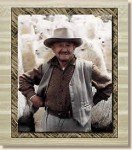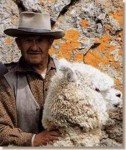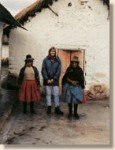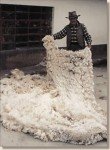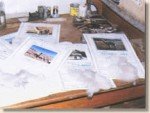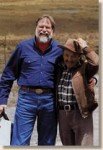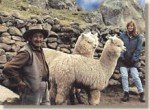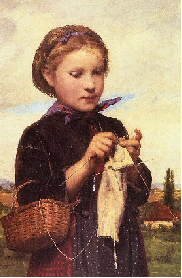The World’s Finest Alpaca Breeder; Don Julio Barreda
by Mike Safley

Don Julio Barreda’s mother, Dona Victona Aragon Barreda, bred alpacas prior to bringing Julio into the world. Julio felt the pulse of the alpaca as a young boy. He Iearned the art of breeding camelids and harvesting their fiber beginning at 13 years of age.
Today, Don Julio is one of the most important Peruvian alpaca ranchers. His ranch “Accoyo,” an Indian word meaning “sandy ground,” lies near the village of Macusani, 16,500 feet above sea level. National Geographic Magazine has called Macusani the world center for alpaca fiber production.
To understand the true history of the alpaca, one must look to Peru, where textiles have played an important part in the civilization of the high Andes since pre-lnca times. During the day of the Incan empire, alpaca husbandry was very carefully regulated by the “Camayocc,” or alpaca professional. The spinning and weaving of alpaca garments was highly organized; only the Inca rulers and their court were privileged to wear alpaca.
Beginning in the 1970’s, Alpaca breeding suffered in Peru, socialized land reforms adversely impacted the breeding of alpacas. The Shining Path or “Sendero Luminoso” terrorists wreaked havoc on the farms of the Altiplano. Don Julio in his role as a modern day “Camayocc” has perservered. He has managed to maintain his royal bloodlines (Plantel) through thick and thin. Today Don Julio shepherds about 2,000 head. Approximately 75% are huacaya and the balance are suri. The bloodlines of his “Plantel” herd date back to 1946.
From the start, Don Julio has been known as an innovator. He was the first breeder to introduce fencing. Many in Peru thought him to be “loco,” building fences, creating artificial boundaries on the almost unlimited terrain, but it wasn’t long before the benefits of this radical concept became apparent. Not only could fenced plots support more animals by utilizing pasture rotation, but the alpaca were better nourished, had higher fertility rates, and lower cria mortality rates.
The benefit of fencing did not stop with better nutrition. This innovation allowed for the separate breeding of suri and huacaya. Llamas could not be crossbred with alpacas. Don Julio began to develop truly purebred alpacas of the highest quality.
Today, after many years of rigorous genetic selection, Barreda has redefined the alpaca. His ranch maintains two herds of huacaya. One herd produces a fine, but less dense fleece of 20 microns or less. The other herd produces a very dense fleece of up to 24 microns. Most of these alpaca produce over 10 pounds of fleece annually.
At 84 years of age, Don Julio’s time is split between Macusani and Arequipa. He returns to the mountains every two months to spend time supervising his herd, thereby ensuring that his workers do the culling, breeding, feeding, mating, shearing, parturition, and weaning according to his exacting standards.
Even with all these accomplishments, he and his lovely wife, Antonieta de Barreda, have found time to rear four daughters and many grandchildren. Peru will remember Don Julio Barreda for many years to come. He has contributed to his country, his family and his Alpacas in a fashion that is admired by all who know him.
What has been accomplished at Don Julio’s beloved “Accoyo” is known to every alpaca breeder in South America. He is truly first among his peers. Now pure Accoyo bloodstock is available to breeders in the United States. American breeders are beginning to appreciate why – Don Julio Barreda is truly the world’s finest Alpaca breeder.
“After more than five decades of breeding, I can identify some modest achievements. The Accoyo herd is uniform in all respects. I have been able to breed well-defined Alpaca phenotypes with an absence of atypical animals. There are no huarizos, suri huacayas or huayaca suris in my herd.
“The Accoyo production charts document a doubling of annual fleece yield per animal since 1946. During the same period, the herd’s average body weight per animal has increased 25%. I have also created a second line of huayaca bloodstock which I call “select.” This herd is being selected for fineness. I have great expectations for this project, and from time to time we end up with exceptional little cria.
“I attribute Accoyo’s success at breeding alpacas with superior production qualities to the father’s lineage. My machos were all bred and selected at Accoyo, and my herd has not suffered from the influence of sires with unknown fathers. I can truly say that the sires of Accoyo have been more than enough and I am proud of the results.”
THE ROAD TO MACUSANI
There is only one way to travel to Macusani – over land, over mountains, and through rain-choked rivers. The roads are narrow, rough, and often non-existent. The ten-hour journey reminds one of the famous rock song, “Shake, Rattle and Roll.” As you break over the mountain pass and descend down the winding path to Macusani, you realize there is nothing soft about Peru. Jagged, staggering, harsh, and stark are the adjectives that come to mind. The Indians are stoic, their faces reflecting the solitude of the Peruvian Altiplano. The alpaca is one of the few living things to prosper in these circumstances, always beautiful, faithfully providing life’s basics to their Quecha Indian masters.
MACUSANI, CENTER OF THE ALPACA UNIVERSE
The green hills and mountains that surround Macusani are punctuated by herds of white and fawn alpacas tended by Indian women dressed in skirts of brilliant blue, yellow and red. The town itself is arranged around a central square, which is dominated by a huge, barrel-roofed church. The town has recently acquired street lights and a new red brick school built by Alberto Fuji Mori, the popular past Peruvian president.
Macusani is known for producing the “Fiber of the Gods” or the “alpaca fleece grown close to heaven.” Every year, representatives of Grupo Inca and Mitchell Bros. find their way to Macusani, which sits at the foot of Allin Capac (“the mighty one”), to purchase bales of alpaca, which fuel the textile mills of Arequipa.
LIFE IN THE ALTIPLANO
Life is not easy at 15,000 feet. The air is thin, the pasture sparse. In the Peruvian Altiplano, the people eat sopa (soup) for breakfast, lunch and dinner. For variety, they have meat and potatoes in their sopa and then change at the next meal to potatoes and meat. The next day they might eat just meat and the day after that potatoes. Life here is basic and one has to wonder why the alpaca with its luxurious fleece, multiple colors, and soft manner, has chosen to call the harsh Peruvian mountains home.
ACCOYO, A NATURAL FIBER FACTORY
Alpacas are ultimately judged on their ability to produce high quality fiber. At Accoyo, ranch records document a doubling of fleece production, on a per animal basis, since 1946. The dramatic nature of these results was demonstrated when 462 huacayas were shorn prior to entering quarantine for the 1995 Five Star Alpaca Import Sale. Of the 462 huacayas, 92 were from Accoyo. The Accoyo fleeces averaged 8.61 pounds. The 370 fleeces from six other farms averaged 6.31 pounds – a difference of 2.3 pounds, or 36%, per animal per year. The fleece of this select group of Accoyo huacayas averaged 22.13 microns and some had micron counts as low as 17. The average standard deviation was 4.82 microns and the co-efficient of variation averaged 22.91%. These results are even more amazing based on the fact that the average Accoyo animal was three years old.
THE “PLANTEL” ALPACA
At Accoyo, each alpaca is first bred for size. Next, the alpaca are selected for their fleece density. Bigger animals with more fleece per square inch produce more fleece per shearing.
People are amazed to see alpaca after alpaca yielding a minimum of 10 pounds of fleece from the annual shearing. Several males’ fleeces from the Plantel herd weighed over 14 pounds.
Samples of fleece from the males in the Accoyo Plantel herd were analyzed by Yocom-McColl Testing Laboratories in Denver, Colorado. The results document a herd of alpacas with low micron fleece (often 20 or less, low standard deviations (often less than 4), and low coefficient of variation (often less than 20%).
THE ART AND SCIENCE OF HERDSIRE SELECTION
Don Julio Barreda takes great pride in the machos of Accoyo. He has been relentless in his pursuit of genetic excellence, rigorously culling and refining his bloodlines for 50 years. A male’s first test at Accoyo falls on the anniversary of his birth. The yearling is sheared and if he does not produce six pounds of fleece he is culled. The next test is at two years of age when the potential herdsire must produce ten pounds of fleece to survive.
Fleece weight is not the only measure of quality. Each macho must have a refined elegance, Accoyo’s trademark head, large stature, and fine, uniform fleece. “Seventy percent of the entire Accoyo fleece clip grades baby,” says Peter Kothe, the man in charge of buying fleece for Mitchell Bros., one of the world’s largest purchasers of alpaca fleece. Kothe also says the “entire clip” includes leg, belly, and neck fiber from the total herd, young and old, not just the “Royal Family” or “Plantel” Alpacas – amazing testimony to the quality of the Accoyo production.
PEDIGREES: A HISTORY OF SUCCESS
The father’s lineage is at the heart of the Accoyo breeding philosophy. “I’ve kept pedigrees for all my machos” says Don Julio. “Each pedigree indicates both the fleece weight and micron count of the fleece harvested during the alpacas first two shearings.” The Accoyo pedigrees have a lock of fleece attached, from each shearing, together with all the other pertinent information.
The breeding males of Accoyo are selected from the “Royal Family” which is maintained for the exclusive purpose of producing herdsires. The “Royal Family” or Plantel animals make up 20% of the entire herd. Bloodstock from the Plantel herd are sold to commercial producers throughout Puno, Peru.
THE “COWBOYS” OF ACCOYO
Most of the men and women who work at Accoyo were born there. Many of their fathers and mothers grew up with Don Julio. They are Quecha Indians, descendants of the Incas. They understand alpacas, their moods, habits and needs. The men do the heavy work, such as shearing and building fences. The women often tend the alpacas in the field, watching their every move, assisting the birth of cria, or moving them to greener pasture. Everyone at Accoyo owes their existence to the alpaca.
ESTANCIA ACCOYO
The Barreda family of Peru has raised all kinds of livestock for many generations. The family once maintained a second farm where they bred fighting bulls and brown Swiss cattle. When the Peruvian land reforms were instituted, Don Julio was given a choice – keep the cattle ranch or Accoyo. He chose Accoyo.
Fighting bulls and cattle are very prestigious in Peru and his other property was larger and better located. “Why,” his friends asked, “did he choose to retain Accoyo?” His reply, “I love my alpacas.”
When it came time to sign the papers transferring his property, the government men pressed Don Julio for the “real” reason he chose Accoyo. Finally, he confessed – yes, there was another reason. Don Julio told the men, who were confiscating a part of his heritage, that it was his hope in living at Accoyo, so far from civilization and so close to heaven, that he might never again see the bureaucrats from Lima.
I first heard Don Julio Barreda’s name in 1990. I had asked a Peruvian friend, who was in the alpaca fleece buying business, a simple question, “Who has the best Alpacas in Peru?” My friend replied, without hesitation, “Don Julio Barreda.”
My first opponunity to inspect Alpaca from Accoyo was during a trip I made to Peru in 1991. I inspected 24 machos which had just been purchased by Grupo Inca for their breeding operation at Sallalli. I was amazed by the beauty of these alpacas.
I arranged to meet Don Julio Barreda shortly after viewing his males at Sallalli. I was immediately attracted by his kind, honest demeanor and his willingness to share his knowledge of Alpacas. I invited him to our ranch in Oregon as the guest of honor at the first ever Alpaca Fest International. He graciously agreed to attend and made his first journey to the United States at the age of 74.
All of these events occurred when it was still illegal to export alpacas from Peru. At that time, I could only dream of owning Alpacas from Accoyo. The laws of Peru were finally changed, and in 1994 the first Accoyo alpacas were delivered to our ranch. We now have over 20 of these lovely animals – a dream come true.
Today, you too can own this fine bloodstock. Call me and we’ll talk about the future of our industry. Call us at (503)-ALPACAS
